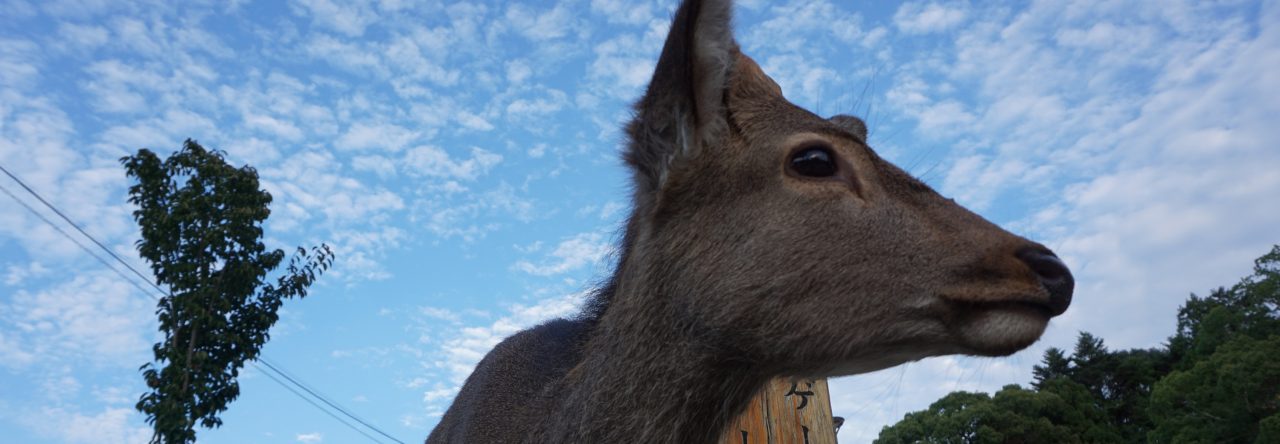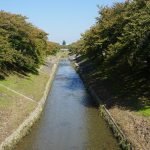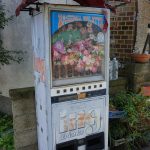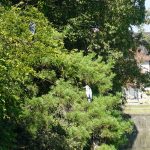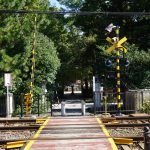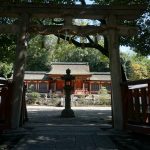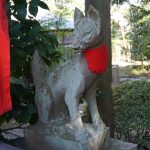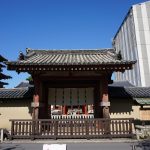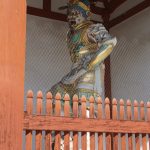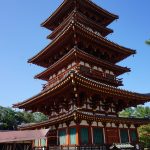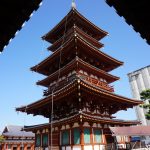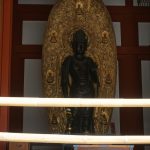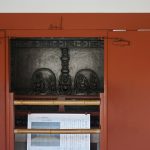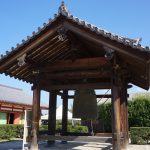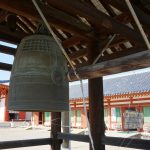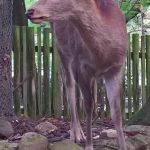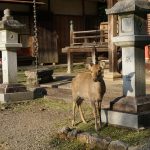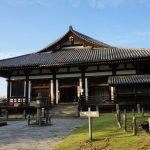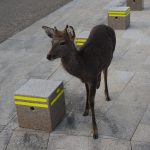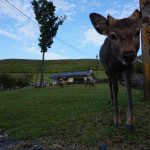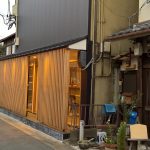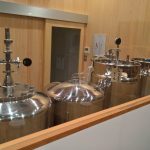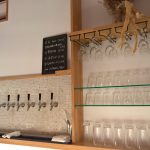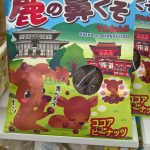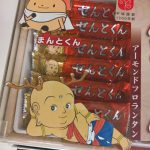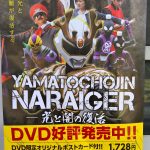Friday 27th
 Long walk out to Yakushi-ji temple/shrine complex. Unlike the old town on the east, west of Nara station you are straight into a modern Japanese town, apartment blocks, homes, shops, some industrial. Spied another old vending machine, faded from decades out in the sun.
Long walk out to Yakushi-ji temple/shrine complex. Unlike the old town on the east, west of Nara station you are straight into a modern Japanese town, apartment blocks, homes, shops, some industrial. Spied another old vending machine, faded from decades out in the sun.
Walked along the Saho River, it runs in a wide concrete trough but at least is tree lined – the width and depth of the trough (and the sand banks where there are wider areas) indicated just how much rainfall it has to cope with at times. Another typhoon on the way this Sunday night, hope it doesn’t mess up my flight…
Yakushi-ji is one of the most famous imperial and ancient Buddhist temples in Japan, that was once one of the Seven Great Temples of Nanto, located in Nara. The temple is the headquarters of the Hossō school of Japanese Buddhism. More info at https://en.wikipedia.org/wiki/Yakushi-ji and other sites. One of the two pagodas flanking the main hall was covered with scaffolding and hidden away while undergoing a full restoration and maintenance.
- Old and new
- Kitsune
- Temple guardian #1
- Temple guardian #2
 Bus back to Nara centre, then walked a northerly route toward the temple complexes at Nara park. Again, followed the river for some of the way, then up a steep track that (according to Google Maps) should take me into the back of the whole complex. Track ends in a bolted gate. Hmph. Luckily it wasn’t padlocked, so made my way through to a path that was rarely walked along in the forest – deep drifts of leaves and rotted branches.
Bus back to Nara centre, then walked a northerly route toward the temple complexes at Nara park. Again, followed the river for some of the way, then up a steep track that (according to Google Maps) should take me into the back of the whole complex. Track ends in a bolted gate. Hmph. Luckily it wasn’t padlocked, so made my way through to a path that was rarely walked along in the forest – deep drifts of leaves and rotted branches.
Got to the temple complex, and wandered for a time taking photos of rarely co-operative, but very photogenic, deer.
Wandered down into Naramachi again, seeking out a brewpub called なら麦酒ならまち醸造所/麦舎(むぎや)- the name in brackets translates as ‘Mugiya’. 3 of their own brewed beers (brewed 200 litres at a time on premises), and great izakaya/tapas style food. Much needed after the days hiking.
A quick aside about the deer of Nara
According to local folklore, sika deer from this area were considered sacred due to a visit from Takemikazuchi-no-mikoto, one of the four gods of Kasuga Shrine.He was said to have been invited from Kashima Shrine in present-day Ibaraki Prefecture, and appeared on Mt. Mikasa riding a white deer. From that point, the deer were considered divine and sacred by both Kasuga Shrine and Kōfuku-ji. Killing one of these sacred deer was a capital offense punishable by death up until 1637, the last recorded date of a breach of that law.
 After World War II, the deer were officially stripped of their sacred/divine status, and were instead designated as national treasures and are protected as such. Today, visitors can purchase “deer-crackers” (鹿煎餅 Shika-senbei) to feed the deer in the park. They are also known as the bowing deer, because given a little encouragement they will bow to you to get their feed of crackers. But they can also be a little… ‘pushy’ when it comes to their food, and the sign here gives fair warning that they’re still wild animals, no matter how cute.
After World War II, the deer were officially stripped of their sacred/divine status, and were instead designated as national treasures and are protected as such. Today, visitors can purchase “deer-crackers” (鹿煎餅 Shika-senbei) to feed the deer in the park. They are also known as the bowing deer, because given a little encouragement they will bow to you to get their feed of crackers. But they can also be a little… ‘pushy’ when it comes to their food, and the sign here gives fair warning that they’re still wild animals, no matter how cute.
 Since the deer are a symbol of Nara, they have unsurprisingly been used as the basis of the cute mascots of Nara city. Sento-kun, half deer half Buddhist novice, has been described as “kimo-kawaii” – cute but grotesque. Then Shikamaro-kun – a cute stylised sika deer – came along, and is much more popular. I’ll let you decide from the pictures, but I think the Sento-kun statue is possibly the weirdest! There’s also a recent film project, in the vein of the Power Rangers, called “Yamatochogin Naraiger” – Yamato Superman Naraiger! If you ever wanted to know what a deer turned into a Power Ranger looks like – now you do.
Since the deer are a symbol of Nara, they have unsurprisingly been used as the basis of the cute mascots of Nara city. Sento-kun, half deer half Buddhist novice, has been described as “kimo-kawaii” – cute but grotesque. Then Shikamaro-kun – a cute stylised sika deer – came along, and is much more popular. I’ll let you decide from the pictures, but I think the Sento-kun statue is possibly the weirdest! There’s also a recent film project, in the vein of the Power Rangers, called “Yamatochogin Naraiger” – Yamato Superman Naraiger! If you ever wanted to know what a deer turned into a Power Ranger looks like – now you do.
- Hmm.
- Eeeewww.
- Yes, these are chocolate deer droppings…
- Oh hell no.
- ?
